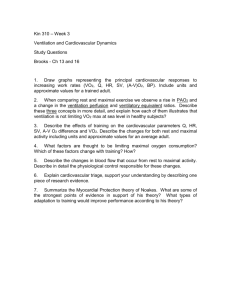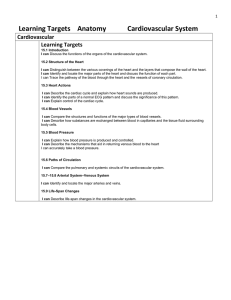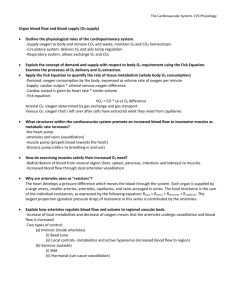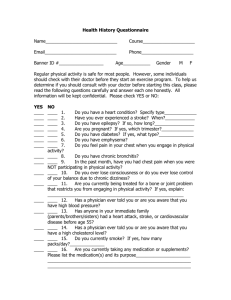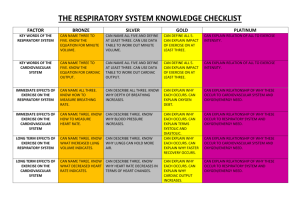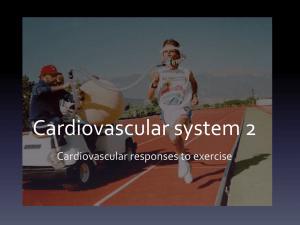Circulatory Responses #2
advertisement
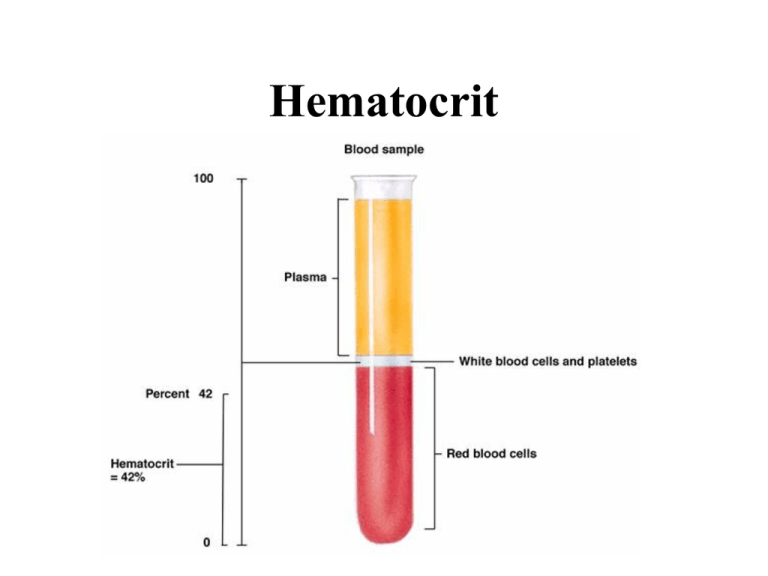
Hematocrit • hematocrit is the percentage of whole blood which is composed of solid material – cells, platelets etc • the blood is composed primarily of water (~55 %) called plasma – the hematocrit would be 45 • can vary between 40 and 50 Pressure Difference Drives Blood Flow in the Systemic Circuit Pressure Changes Across the Systemic Circulation Why the pressure change? • Blood flow = change in pressure / resistance • increases in pressure at the beginning or decreases in pressure at the end will increase blood flow • this could result in increased resistance to compensate (homeostasis) Resistance • the most important factor determining blood flow is resistance • the most important factor determining resistance is the radius of the vessel • Resistance = Length X viscosity / radius4 Cardiac Output during Exercise • Q increases in direct proportion to the metabolic rate required to perform task • linear relationship between Q and VO2 • remember... Q = HR x SV Stroke Volume and Heart Rate during Exercise • in untrained or moderately trained individuals stroke volume plateaus ~ 40% VO2 max • at work rates > 40% VO2 max, Q increases by HR alone • See fig 9.17 Changes in Cardiovascular Variables During Exercise The Fick Equation • VO2 = Q x (a-vO2 diff) • VO2 is equal to the product of cardiac output and arterial-mixed venous difference • an increase in either Q or a-vO2 difference will result in an increase in VO2max Redistribution of Blood Flow • Increased blood flow to working skeletal muscle • Reduced blood flow to less active organs – Liver, kidneys, GI tract Changes in Muscle and Splanchnic Blood Flow During Exercise Increased Blood Flow to Skeletal Muscle During Exercise • Withdrawal of sympathetic vasoconstriction • Autoregulation – Blood flow increased to meet metabolic demands of tissue – O2 tension, CO2 tension, pH, potassium, adenosine, nitric oxide Redistribution of Blood Flow During Exercise Circulatory Responses to Exercise • Heart rate and blood pressure • Depend on: – Type, intensity, and duration of exercise – Environmental condition – Emotional influence Transition From Rest Exercise and Exercise Recovery • Rapid increase in HR, SV, cardiac output • Plateau in submaximal exercise • Recovery depends on: – Duration and intensity of exercise – Training state of subject Cardiovascular Responses during Transitions Incremental Exercise • Heart rate and cardiac output – Increases linearly with increasing work rate – Reaches plateau at 100% VO2max • Systolic blood pressure – Increases with increasing work rate • Double product – Increases linearly with exercise intensity – Indicates the work of the heart Double product = heart rate x systolic BP Arm vs. Leg Exercise • At the same oxygen uptake arm work results in higher: – Heart rate • Due to higher sympathetic stimulation – Blood pressure • Due to vasoconstriction of large inactive muscle mass . Heart Rate and Blood Pressure During Arm and Leg Exercise Prolonged Exercise • Cardiac output is maintained – Gradual decrease in stroke volume – Gradual increase in heart rate • Cardiovascular drift – Due to dehydration and increased skin blood flow (rising body temperature) . HR, SV, and CO During Prolonged Exercise Summary of Cardiovascular Adjustments to Exercise Summary of Cardiovascular Control During Exercise • Initial signal to “drive” cardiovascular system comes from higher brain centers • Fine-tuned by feedback from: – Chemoreceptors – Mechanoreceptors – Baroreceptors A Summary of Cardiovascular Control During Exercise



